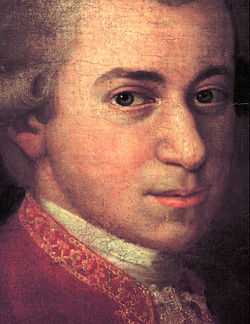Piano Concerto No. 15 (Mozart)
The Piano Concerto No. 15 in B-flat major, KV. 450 is a concertante work for piano and orchestra by Wolfgang Amadeus Mozart. Mozart composed the concerto for performance at a series of concerts at the Vienna venues of the Trattnerhof and the Burgtheater in the first quarter of 1784, where he was himself the soloist in March 1784.[1][2]
In a letter to his father, Mozart compared this concerto with the 16th concerto in D:
"I consider them both to be concertos which make one sweat; but the B flat one beats the one in D for difficulty."[3]
Indeed, many pianists consider this to be one of the more difficult of Mozart's piano concertos.[4] The concerto is primarily difficult from its many quick scale patterns which must be played perfectly and also from its many fast chord patterns moving up and down. Beginning with this concerto, Mozart began to use the term "grand" to describe his concerti such as K.450 which feature a prominent and required wind section for the ensemble.[5]
The work is orchestrated for solo piano, flute, two oboes, two bassoons, two horns, and strings. The concerto is in three movements:
- Allegro
- Andante in E-flat major
- Allegro
Diana McVeigh has commented on the division of musical themes in the concerto's first movement, in the context of the relationship between soloist and orchestra.[6] The finale follows the even rondo form.[7]
Simon Keefe has noted contemporary comments from Mozart's era on how the woodwind writing in this concerto showed a "newly intricate and sophisticated" character compared to Mozart's prior keyboard concerti.[1] Keefe has also analysed the character of the dialogue between the soloist and the orchestra in the concerto's first movement.[8] Elaine Sisman has postulated that Mozart modeled the slow movement on a theme-and-variations movement from the Symphony No. 75 of Joseph Haydn.[9]
References
- ↑ 1.0 1.1 Keefe, Simon P. (4 November 2001). "'An Entirely Special Manner': Mozart's Piano Concerto No. 14 in E Flat, K.449, and the Stylistic Implications of Confrontation". Music & Letters 82 (4): 559–581. doi:10.1093/ml/82.4.559. JSTOR 3526277.
- ↑ Eisen, Cliff; Mozart, Wolfgang Amadeus; Wolff, Christoph; Zacharias, Christian (1994). "Music Reviews: Wolfgang Amadeus Mozart: Klavierkonzerte für Klavier und Orchester. Ausgaben für zwei Klaviere. Urtext; hrsg von. Christoph Wolff und Christian Zacharias". Notes (2nd Ser.) (Music Library Association) 51 (2): 733–737. doi:10.2307/898906. JSTOR 898906.
- ↑ Hutchings (p. 290)
- ↑ Steinberg
- ↑ Keefe, Simon P., The Cambridge Companion to Mozart. Cambridge University Press (2003, ISBN 0-521-80734-4), p. 88.
- ↑ McVeagh, Diana (April 1947). "The Concerto: Contest or Co-Operation?". Music & Letters 28 (2): 115–120. doi:10.1093/ml/XXVIII.2.115. JSTOR 855524.
- ↑ Portowitz, Adena (December 2001). "Art and Taste in Mozart's Sonata-Rondo Finales: Two Case Studies". The Journal of Musicology 18 (1): 129–149. doi:10.1525/jm.2001.18.1.129. ISSN 0277-9269. Retrieved 2008-03-15.
- ↑ Keefe, Simon P. (Summer 1999). "Dramatic Dialogue in Mozart's Viennese Piano Concertos: A Study of Competition and Cooperation in Three First Movements". The Musical Quarterly 83 (2): 169–204. doi:10.1093/mq/83.2.169. Retrieved 2008-03-08.
- ↑ Mercado, Mario R.; Zaslaw, Neal (June 1999). "Book Review: Mozart's Piano Concertos: Text, Context, Interpretation by Neal Zaslaw". Notes (2nd Ser.) (Music Library Association) 55 (4): 879–883. doi:10.2307/899584. JSTOR 899584.
Sources
- Hutchings, Arthur, A Companion to Mozart's Piano Concertos, Oxford University Press (original publication, 1948).
- Steinberg, Michael, The Concerto: A Listener's Guide, Oxford (1998, ISBN 0-19-510330-0)
External links
- Konzert in B KV 450: Score and critical report (German) in the Neue Mozart-Ausgabe
- Piano Concerto No. 15: Scores at the International Music Score Library Project
| ||||||||||||||||||||
